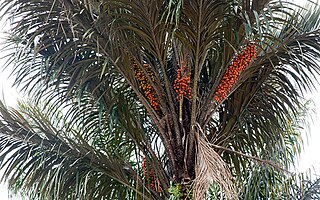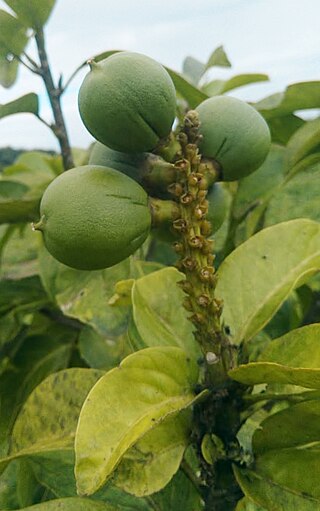
The Brazil nut is a South American tree in the family Lecythidaceae, and it is also the name of the tree's commercially harvested edible seeds. It is one of the largest and longest-lived trees in the Amazon rainforest. The fruit and its nutshell – containing the edible Brazil nut – are relatively large, possibly weighing as much as 2 kg (4.4 lb) in total weight. As food, Brazil nuts are notable for diverse content of micronutrients, especially a high amount of selenium. The wood of the Brazil nut tree is prized for its quality in carpentry, flooring, and heavy construction.

Belém often called Belém of Pará, is a Brazilian city, capital and largest city of the state of Pará in the country's north. It is the gateway to the Amazon River with a busy port, airport, and bus/coach station. Belém lies approximately 100 km upriver from the Atlantic Ocean, on the Pará River, which is part of the greater Amazon River system, separated from the larger part of the Amazon delta by Ilha de Marajó. With an estimated population of 1,499,641 people — or 2,491,052, considering its metropolitan area — it is the 11th most populous city in Brazil, as well as the 16th by economic relevance. It is the second largest in the North Region, second only to Manaus, in the state of Amazonas.

The International Center for Tropical Agriculture is an international research and development organization dedicated to reducing poverty and hunger while protecting natural resources in developing countries. It is based in Palmira, Colombia, where it employs over 300 scientists.

Amazônia Legal, also known as Brazil's Legal Amazon (BLA), is the largest socio-geographic division in Brazil, containing all nine states in the Amazon basin. The government designated this region in 1948 based on its studies on how to plan the economic and social development of the Amazon region.

Bactris gasipaes is a species of palm native to the tropical forests of Central and South America. It is well spread in these regions, where it is often cultivated by smallholders in agroforestry systems or more rarely, in monoculture. Common names include peach palm in English, among others used in South American countries. It is a long-lived perennial plant that is productive for 50 to 75 years on average. Its population has an important genetic diversity, leading to numerous fruits, colors, and qualities. The fruits are edible and nutritious but need to be cooked for 30 minutes to five hours. They also benefit many animals in the wild. Peach-palms are also cultivated for the heart of palm, and the trunk can make valuable timber.

Mauritia flexuosa, known as the moriche palm, ité palm, ita, buriti, muriti, miriti (Brazil), canangucho (Colombia), morete (Ecuador), or aguaje (Peru), is a palm tree. It grows in and near swamps and other wet areas in tropical South America.

The National Institute of Amazonian Research is a public educational and research institution headquartered in Manaus, Brazil. It was founded in 1952, with the purpose of furthering scientific knowledge of the Brazilian Amazon Region. Most of INPA's research focuses on tropical forest management, ecology, molecular ecology, zoology, botany, tropical agriculture and tropical pisciculture. The institution also maintains important vertebrate, invertebrate, and vascular plants research collections.

Astrocaryum vulgare is a very spiny palm native to the Guianas and the Amazon. It is species which has greatly benefited from deforestation, as it cannot grow in undisturbed rainforest. In Brazil it is considered typical of Pará state in the north of the lower Amazon. This plant has edible fruit.

Oenocarpus bacaba is an economically important monoecious fruiting palm native to South America and the Amazon rainforest, which has edible fruits. This plant is cited in Flora Brasiliensis by Carl Friedrich Philipp von Martius. It can reach up to 20–25 metres tall and 15–25 cm in diameter. It grows in well-drained sandy soils of the Amazon basin.

Oenocarpus is a genus of pinnate-leaved palms (Arecaceae) native to Trinidad, southern Central and tropical South America. With nine species and one natural hybrid, the genus is distributed from Costa Rica and Trinidad in the north to Brazil and Bolivia in the south.

Oenocarpus bataua, the patawa, sehe, hungurahua (Ecuador) or mingucha, is a palm tree native to the Amazon rainforest. The tree produces edible fruits rich in high-quality oil.

The Southwest Amazon moist forests (NT0166) is an ecoregion located in the Upper Amazon basin.
Bela "Bert" Grof was a Hungarian-born Australian agricultural researcher with contributions to grassland and forage research in the tropics.
Rwira is an agricultural village in the Commune of Rutovu in Bururi Province in southern Burundi. It lies to the west of Rutovu. It is a place known for its bean production.

Anchylorhynchus is a genus of weevils belonging the family Curculionidae and subfamily Curculioninae. It currently includes 25 described species distributed from Panama to Argentina. Members of the genus are pollinators of palms in the genera Syagrus, Oenocarpus and Butia, with adults living in inflorescences and larvae feeding on developing fruits. The first instar larvae of Anchylorhynchus have an unusual morphology, being specialized on killing other larvae infesting the palm fruits.
Campina is a Neotropical ecoregion found in the Amazon biome. It refers to vegetation that grows on infertile sandy soil with poor drainage. The term may be used to include open forest, shrubland and meadow, or may be restricted to treeless meadows.
Sheila Maureen Bisilliat is an English-born Brazilian photographer.

Caryodendron orinocense, commonly known as cacay, inchi or orinoconut, is an evergreen tree belonging to the family Euphorbiaceae.
The 2021 Torneio Internacional de Manaus de Futebol Feminino was the tenth edition of the Torneio Internacional de Futebol Feminino, an invitational women's football tournament held every December in Brazil. The tournament ran in between 25 November–1 December, 2021.














